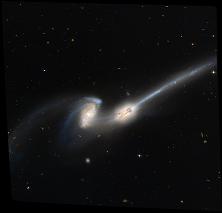

Galaxies appear to grow by gobbling up other galaxies with their black holes eventually merging. Our own galaxy and its twin the Andromeda galaxy are both accompanied by dozens of globular clusters which are compact spherical groups of up to a million stars and also dozens of much smaller galaxies or clouds of stars. Some may be the remains of galaxies that our Milky Way has gobbled up and some like the Magellanic Clouds in the southern hemisphere may be about to be gobbled up by our Galaxy. 'About to be' is a relative term. Our galaxy rotates about its centre every 200 million years. A gobbling up process may take almost as long as that to complete.

Credit : NASA,
H. Ford (JHU), G. Illingworth (UCSC/LO), M.Clampin (STScI),
G. Hartig (STScI), the
ACS Science Team, and ESA
Hubble Space Telescope image of the mice galaxy. The mice galaxy is in fact
two galaxies that are colliding with each other. Eventually over millions
of years the two galaxies will merge.